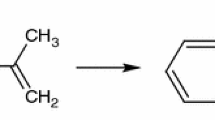Abstract
2-Methylene-1,3-dioxepane (MDP) was copolymerized with ethylene (E) at a pressure of approximately 1000 psi and a temperature of approximately 70°C with AIBN as the free radical initiator. The copolymers obtained, poly(MDP-co-E), were characterized by elemental analysis, IR, 1H-NMR and 13C-NMR spectroscopy, DSC, and GPC. The copolymers contained 2–15 mol% ester units. MDP was also copolymerized with styrene (S) at 120°C with di-t-butyl peroxide as the initiator to prepare the copolymer, poly(MDP-co-S). The number-average molecular weights of both types of copolymers were in the range of 6000 to 11,000, and the weight-average molecular weights were in the range of 9000 to 17,000. The melting temperatures of poly(MDP-co-E) decreased with increasing ester unit content in the copolymer. For the MDP-S copolymers, the glass transition temperatures decreased with increasing ester unit content. Both poly(MDP-co-E) and poly(MDP-co-S) were degraded by methanolysis, and their molecular weights decreased by the expected amounts based on the ester unit content.
Similar content being viewed by others
REFERENCES
R. W. Lenz (1993) Adv. Polymer Sci. 107, 1–40; M. R. Timmins and R. W. Lenz (1994) Trends Polymer Sci. 2, 15-15.
A. C. Albertsson and B. Ranby (1976) in J. M. Sharpley and A. M. Daplan (Eds.), Proceedings of the Third International Biodegradation Symposium, Applied Science, Essex, England, pp. 743–745.
D. G. Corbin, cited by T. J. Henman (1981) Proceedings of the Third International Conference on Advances in the Stabilization of Polymers, Lucerne, Switzerland, p. 116.
W. J. Bailey, Z. Ni, and S. Wu (1982) J. Polym. Sci. Poly. Chem. Ed. 20, 3021–3030.
W. J. Bailey and B. Gapud (1984) Polym. Prepr. Am. Chem. Soc. Div. Polym. Chem. 27(1), 58–59.
B. H. Chang and T. S. Brima (1993) U.S. Patent 5,270,411.
W. J. Bailey, V. K. Kuruganti, and J. S. Angle (1990) in J. E. Glass and G. Swift (Eds.), Agricultural and Synthetic Polymers, Biodegradability and Utilization, Am. Chem. Soc., Washington, DC, pp. 149–160.
W. J. Bailey and B. Gapud (1984) Polym. Prepr. Am. Chem. Soc. Div. Polym. Chem. 25(1), 111.
W. J. Bailey (1984) in J. E. McGrath (Ed.), Ring-Opening Polymerization, Kinetics, Mechanisms, and Synthesis, Developed from a symposium sponsored by the Division of Polymer Chemistry at the 187th Meeting of the American Chemical Society, St. Louis, MO, pp. 57–65.
R. G. Austin (1994) U.S. Patent 5,281,681.
See, e.g., H. A. Szymanski (1964) Theory and Practice of Infrared Spectroscopy, Plenum Press, New York.
S. L. Aggarwal (1975) in J. P. Brandrup and E. H. Immergut (Eds.), Polymer Handbook, 2nd ed., Wiley-Interscience, New York, III–139.
R. A. Rutherford and W. A. Lee (1975) in J. P. Brandrup and E. H. Immergut (Eds.), Polymer Handbook, 2nd ed., Wiley-Interscience, New York, V–13.
Author information
Authors and Affiliations
Rights and permissions
About this article
Cite this article
Wu, B., Lenz, R.W. Synthesis, Characterization, and Hydrolytic Degradation of Copolymers of 2-Methylene-1,3-dioxepane with Ethylene and with Styrene. Journal of Polymers and the Environment 6, 23–29 (1998). https://doi.org/10.1023/A:1022874411834
Issue Date:
DOI: https://doi.org/10.1023/A:1022874411834




